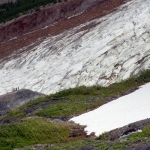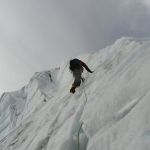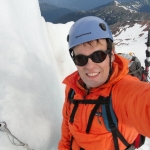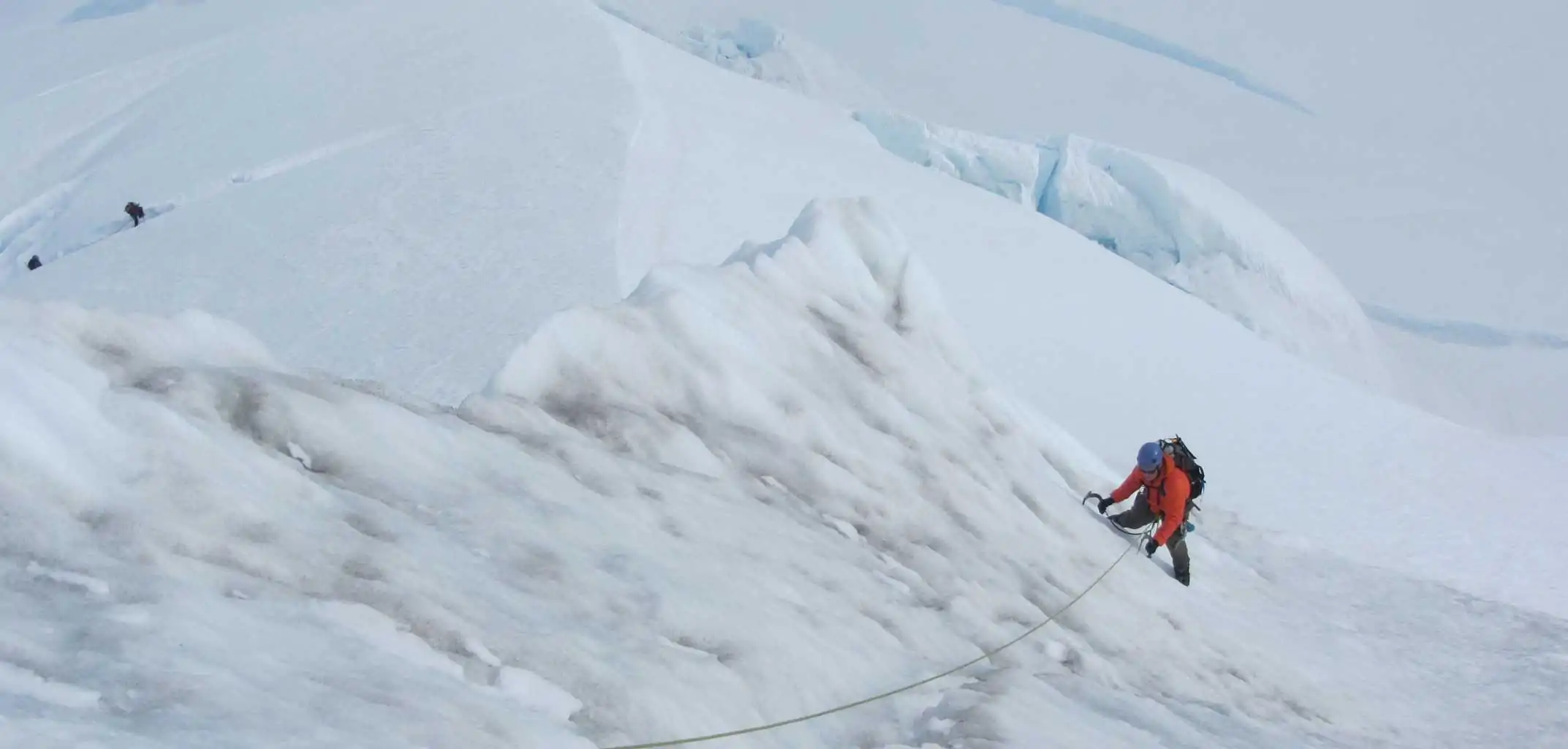I’m back in Washington State for work during the Congressional recess, and the weekend before last I managed to work in a quick, two-day climb of Mount Baker’s North Ridge. Two months ago I was out here for a week-long ice climbing course that was to include an ascent of Baker’s North Ridge, but unfortunately we didn’t have a weather window to even attempt the summit, so this was my return attempt. I hired a guide with the American Alpine Institute for a private, one-on-one climb. Baker stands at 10,781 feet above sea-level and is the second most heavily glaciated peak in the lower 48. The North Ridge lived up to its reputation, and proved to be an amazing climb, involving monster crevasses, circuitous route-finding across the Coleman on our traverse, some rocky-volcanic scree, 50-degree snow slopes, and the crux of the route is a couple pitches of 60-70 degree ice at 9,500 feet. With a 5,000 foot summit day and an immediate hike out, it was certainly the most strenuous climb I’ve done yet, while also undoubtedly being the most amazing and exhilarating climb as well.
Approach to the Hogsback Base Camp
[singlepic id=23 w=540 h=405 float=center]I met up with my guide, Dustin Byrne, at the AAI shop in Bellingham, WA at 7am. There was a large group getting ready to go out, so we went upstairs to get things situated and go through my pack and the gear list. We went through everything and he pointed out a few things I could get away with leaving behind for the two-day ascent in order to save some weight. The drive from Bellingham to the trailhead is about an hour and half, and after getting a few things situated we set off on the trail at about 10am. The Heliotrope Trail is also the approach for the Coleman-Deming route, the most popular route to the summit, and is located at 3,600 feet above sea level. The trail was entirely melted out, so I opted to strap my boots to my pack and hike in wearing my trail runners. The lack of snow was a welcomed change from my last two climbs in the Northwest (Baker in June, and Rainier in July) which were both snow covered from the get-go. The hike up to the Hogsback Camp was pretty leisurely, with a few rock hop river crossings, and a nice grade with a number of switchbacks. We stopped for a quick break at one point but the bugs were so bad that we just decided to continue on. Just as you start to break out of the tree line, you hit the climber’s trail, which is a fairly steep, rocky, and loose trail. The total hike in was about 2 miles, 2,000 vertical feet, and took about 2 hours. We arrived just before noon to find a number of choice flat camp sites scattered around at about 5,700 ft. (our early departure gave us a jump start on the crowds coming up from Seattle).

Mount Baker’s North Ridge
My watch alarm went off at 2:30 that morning, and while I had a good seven hours of sleep (plus some light napping earlier that afternoon), I was still somewhat groggy. I opened the tent fly and got the JetBoil going for morning coffee, while I ate a quick Bobo’s Oat Bar for breakfast and readied the remainder of my gear. We were roped up and on our way at 3:30am. Initially we set off an a gradual ascent to about 6,700 feet where we began our traverse of the mountain to the east. 
It had been two months since the last (and first) time I had climbed ice, and by this point in the day we had already climbed almost 4,000 feet, made a long traverse, and been going for four to five hours. I could definitely already feel it in my legs, so I was a little nervous setting out. First pitch: short traverse to the left around the corner and then up some 60-70 degree alpine ice. Didn’t have any problems getting good purchase with each swing of my Black Diamond Cobras, but the feet need a little work. I don’t have enough experience to speak with any authority on the varying qualities of ice, but obviously it isn’t waterfall ice, and I’d find my crampon points skate occasionally on some crummier sections. The exposure here was pretty huge. While we approached from a steep snow ridge, the side we traversed to essentially just dropped off a few thousand feet with super steep ice down to the Roosevelt Glacier. 
The trickiest portion of the descent is right of the bat when you head down the Roman Wall. You hit the saddle between Baker and Colfax Peak before too long and then you just follow the mellow boot pack down. We hit one more steep downhill section right above camp and the snow had softened considerably by this time and at that elevation… My crampons kept balling up (Black Diamond Cyborgs) and I went down on my butt twice. Taking off the crampons at that point was much better for that last little stretch.
We made it back to camp two hours after leaving the summit and I was pretty beat at this point. It would have been nice to crawl into my tent for a short nap, but instead we started packing up immediately, with the goal of leaving camp again in half an hour. It took me a little longer than that to break camp, and fiddle with my new backpack. I used my CiloGear 60L pack for the first time, and it was an awesome, awesome pack. It was a little too big for a quick two-day ascent, and if I were a rich man I would also get the 45L pack, which would have been ideal. But the ingenious part of the CiloGear packs are the versatility of the straps. I had removed the foam pad, aluminium stay, and brain on the pack for the summit attempt, while also scrunching it down to a minimal carrying capacity, and had to reset all of this to carry a large load again, and also change back into my trail runners. For some reason I got a third or fourth wind as we set out, and we hiked out super fast. Made it back to the car at 3:30, exactly 12 hours after we set out from camp.
All-in-all a really, really great trip. Coolest climb that I’ve done to date, and I really enjoyed the challenge, the variability in terrain, and the views. I wish I had been in a little better shape, this climb was kind of an impulse trip that I signed up for the week beforehand… I hadn’t been climbing, running, backpacking or working out whatsoever since my Rainier trip last month, so I wasn’t at the top of my game, and could have been in a little better shape. But I made it. It was great to get to the summit (I had been 0/2 in the Cascades this year), even if I’ve been to that summit before, this was a whole new route and a big step up from the Easton Glacier route I did last year.
[nggallery id=”baker-north-ridge”]Gear Used
- CiloGear 60L pack – just an amazingly well designed pack for mountaineering. JetBoil Sol Ti – Doesn’t get much better.
- Feathered Friends Jackorack – this is the best little windshirt ever, and has become such a go to piece in my wardrobe.
- Patagonia Nano Puff Pullover – sweet insulating layer, and proved to be the only insulation I needed for these conditions.
- Black Diamond Cobras – great axes for the vertical stuff, although not as handy for regular glacier travel.
- Honestly no gear dislikes or big problems this trip, I kept things pretty minimal… I’m not sure of my final pack weight with group gear, food, water, etc — but I think my personal gear base weight was around 26lbs.
Details
Trip: Private Guided Climb of Mount Baker’s North Ridge
Guide: Dustin Byrne via American Alpine Institute (AAI)
When: August 20 – 21, 2011 (2 Days)
Where: Mount Baker, WA
Cost: $700
Ryan
Latest posts by Ryan (see all)
- Kazakhstan Food: Exploring Some of its Most Delicious Dishes - August 7, 2023
- A Self-Guided Tour of Kennedy Space Center: 1-Day Itinerary - August 2, 2022
- Fairfield by Marriott Medellin Sabaneta: Affordable and Upscale - July 25, 2022
- One of the Coolest Places to Stay in Clarksdale MS: Travelers Hotel - June 14, 2022
- Space 220 Restaurant: Out-of-This-World Dining at Disney’s EPCOT - May 31, 2022

